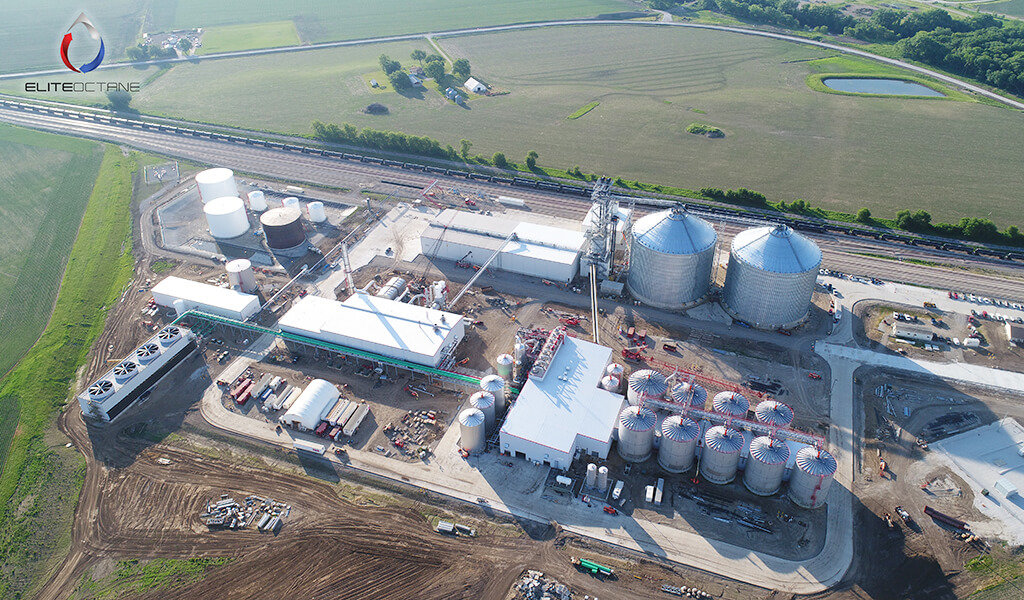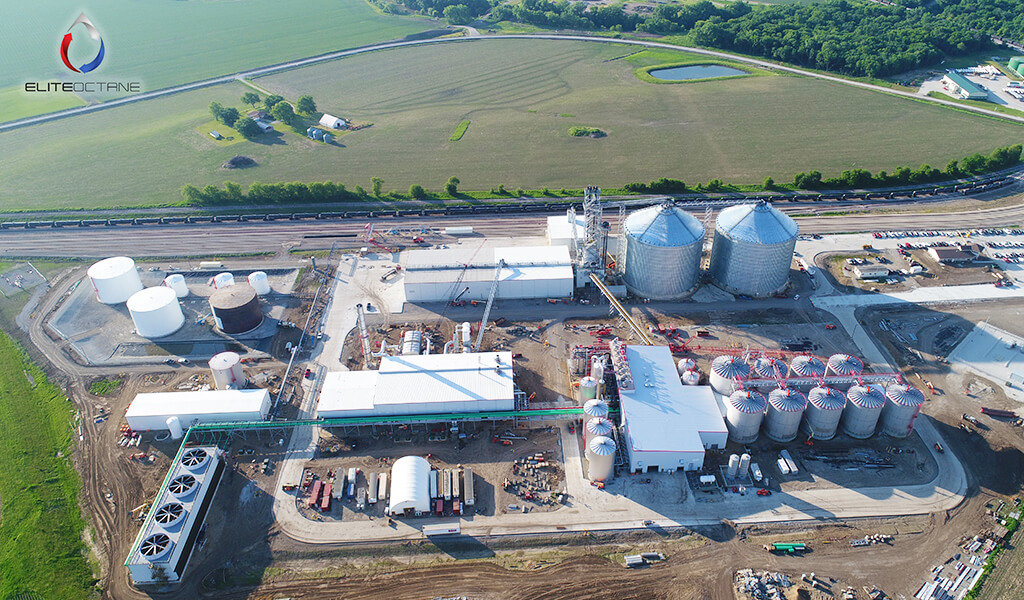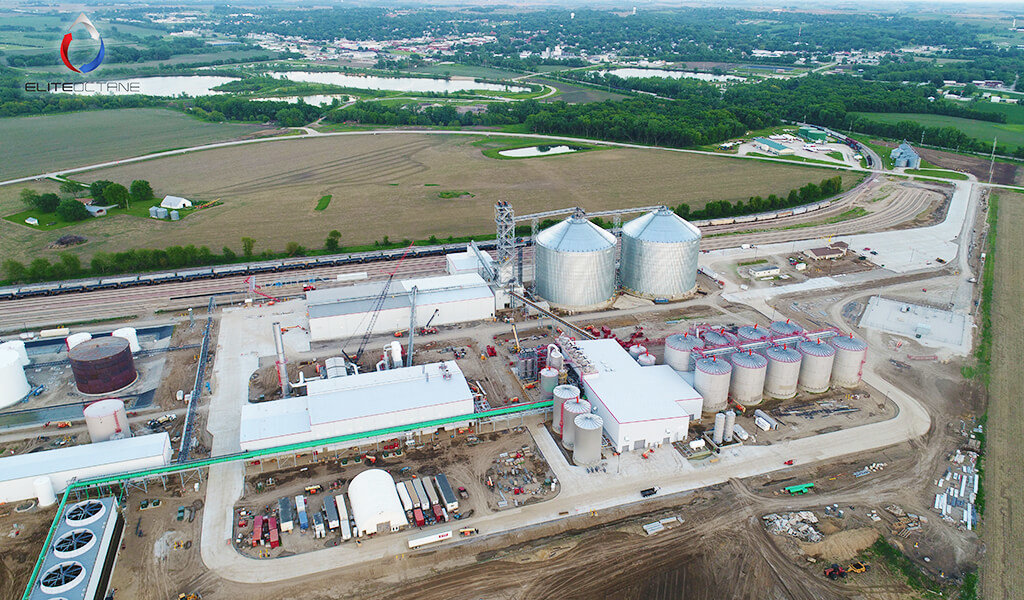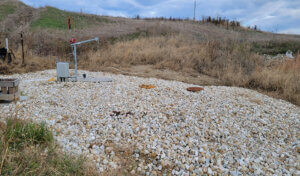
Waste to Ethanol: Transforming Municipal Wastewater into a Community Resource
The new ethanol plant in Cass County, Iowa, just northwest of the City of Atlantic, is transforming wastewater into a cooling resource for ethanol production. This project aligns with a sustainable shift to mitigate concerns about the large amounts of fresh water used in ethanol production on behalf of fuel producers and the communities they call home.
The innovative use of treated municipal wastewater at this ethanol plant is using an average of 1-1.2 million gallons of water per day, which would’ve otherwise come from community wells.
SBR Wastewater Treatment Retrofit for Ethanol Production
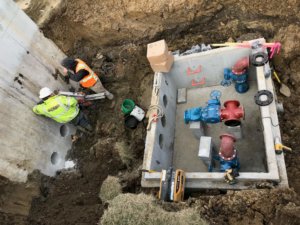
Construction workers drill holes into the SBR wastewater effluent flow equalization tank in order to install pump discharge piping.
The city currently treats wastewater using a sequencing batch reactor (SBR) with UV disinfection. As a product of such treatment, the treated effluent
discharges in large batches, rather than a steady stream. An effluent flow equalization basin reduces the flow capacity through the UV disinfection process. Because disinfection is done in batches, it was determined that an additional holding tank would be needed to transport the treated effluent to the ethanol production facility.
Through an investigation of alternative solutions, the design team identified the possibility to forgo UV disinfection on the City’s end, eliminating the need for an additional holding tank.
While Iowa doesn’t offer design standards for effluent reuse projects, it has historically required all effluent to undergo disinfection before it leaves a wastewater treatment facility to protect human health and the environment.
Since the ethanol facility planned to provide disinfection, engineering justification was made that there wouldn’t be any benefits to having the city provide disinfection as well. In addition, typically required chlorination measures would’ve prompted major installations at the treatment plant because it utilizes UV disinfection, dosed by effluent flow equalization. Adding chlorination injection equipment and chemical storage was a strong objection of the City’s due to negative operational impacts and safety concerns.
Since the project included retrofitting existing treatment processes, care had to be taken not to interfere with the treatment of incoming wastewater. Successful coordination with the City of Atlantic allowed the project to have minimal impact on daily operations at the wastewater treatment facility.
Transporting Wastewater Effluent for Ethanol Production
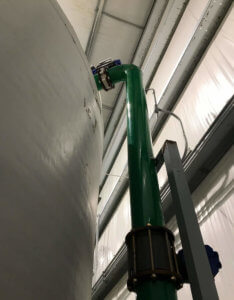
The force main enters the ethanol production facility to deliver wastewater effluent for cooling processes.
To transport the wastewater effluent to the ethanol production plant, the existing effluent flow equalization basin was fitted with three 72 hp submersible pumps. Each pump is capable of pumping 900 GPM, which is sufficient to transfer all the City’s treated effluent to the ethanol facility under typical flow conditions. If less flow is required or the flow exceeds the pumping capacity, UV disinfection before discharge is still possible.
In addition to the pumps, approximately 4,300 feet of 12-inch force main was installed through the right-of-way acquisition of seven easements. Trenchless construction allowed the force main to cross an area railroad, river, and highway. Installation of a flow meter and valves at the wastewater treatment plant allow for ease of operation and maintenance.
Environmentally Friendly Benefits of Wastewater Reuse in Ethanol Production
With the ethanol plant maximizing its demand of treated effluent, the City is saving power as a result of reduced effluent pumping and little to no UV disinfection. Due to little, to no discharge of wastewater to the East Nishnabotna River, there’s little to no need for sampling and analyzing, providing further savings to the City’s wastewater treatment system. The cost of pumping and transferring the treated effluent is born by the ethanol production company, at a reduced rate, when compared to the costs for drilling groundwater wells to supply sufficient drinking water needs.
In addition to serving as an economical source of water for ethanol production, the wastewater effluent is getting further treatment before its reuse. Therefore, it re-enters the environment at a higher quality than current water quality standards require. This project also reduces pollutant loading into the river, which is a popular community place for canoeing and boating.
Engineering Excellence Award for Wastewater Reuse
This project blazes the trail for future ethanol production facilities to use treated wastewater effluent as a substitute for freshwater resources. Iowa is the largest producer of ethanol in the United States, and water demand is one of the biggest environmental downsides to ethanol production. Reusing wastewater effluent minimizes the negative impacts of ethanol production on our precious water resources and encourages the production of green fuel sources.
This project exemplifies that a high level of project success and satisfaction is obtainable when the owner, designer, and contractor closely collaborate in a selfless manner, making project success the only goal.
The innovative use of treated municipal wastewater within the ethanol production process garnered a 2019 Grand Prize Engineering Excellence Award from the ACEC-IA.
Guiding Project Success through Expertise in Wastewater System Design
Snyder & Associates was selected by the Cass County Board of Supervisors to develop a plan for this greywater transmission project. The first step was an analysis of the City of Atlantic’s wastewater discharge flows and communications with the ethanol production company. Wastewater treatment design and preparation of construction documents followed closely.
As the project’s civil engineer, we assembled a team of structural engineers (Shuck-Britson, our subsidiary) and electrical engineers (IMEG Corp) to design and oversee the project from conception to completion. Our team proposed alternative force main routes and helped the Board of Supervisors decide which one would be best to implement.
Obtaining approval of project details from the Iowa DNR ensured the project met DNR requirements. Snyder also helped to coordinate agreements for power usage and equipment ownership between the city and the ethanol production company that’s fair to both parties. Additional client goals were also developed and incorporated into the project through this process.
Snyder served as the lead for client contact and project development, design team coordination, civil design, construction bid phase, construction administration and observation, and start-up services. Civil municipal engineering services provided by our team included acquisition plats and easements, permitting, pump station and force main design, structural design, topographic survey and subsurface utility engineering, and wastewater system analysis and planning.
